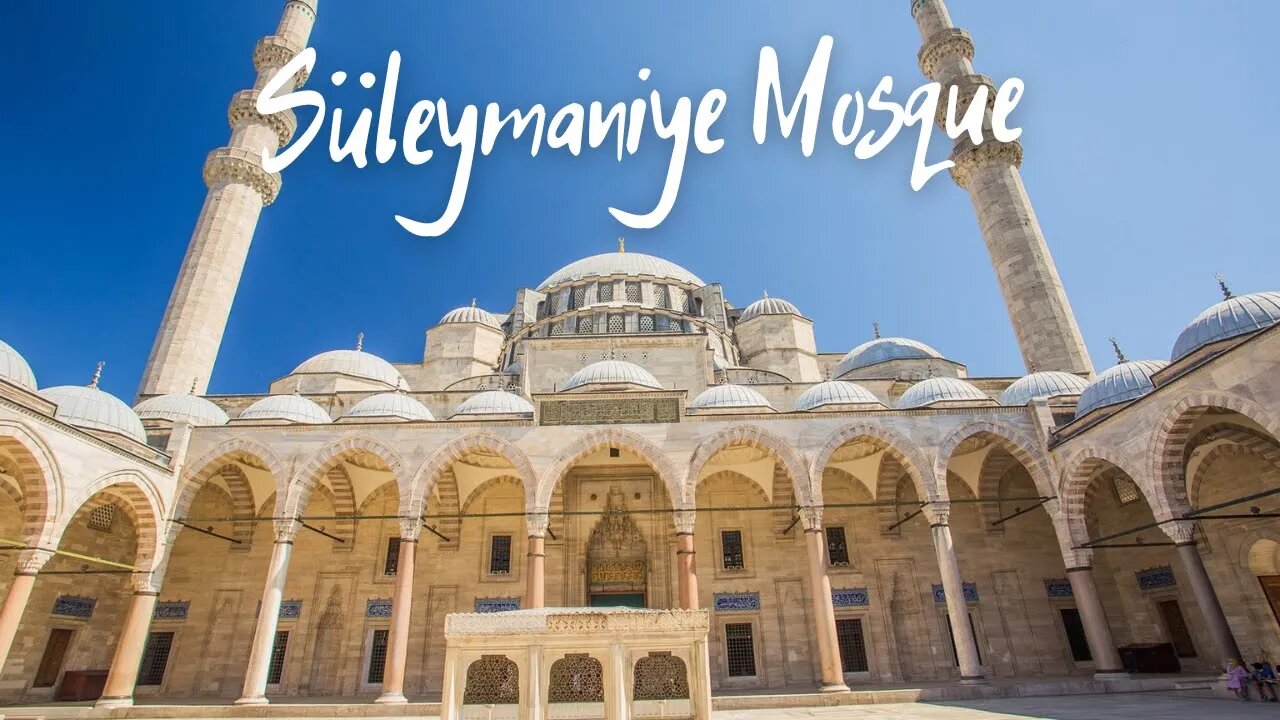Premium Only Content

Süleymaniye Mosque | Istanbul | Turkey | 2023
The Süleymaniye Mosque (Turkish: Süleymaniye Camii, pronounced [sylejˈmaːnije]) is an Ottoman imperial mosque located on the Third Hill of Istanbul, Turkey. The mosque was commissioned by Suleiman the Magnificent and designed by the imperial architect Mimar Sinan. An inscription specifies the foundation date as 1550 and the inauguration date as 1557. Behind the qibla wall of the mosque is an enclosure containing the separate octagonal mausoleums of Suleiman the Magnificent and his wife Hurrem Sultan (Roxelana). For 462 years, the Süleymaniye Mosque was the largest mosque in the city, until it was surpassed by the Çamlıca Mosque in 2019. The Süleymaniye Mosque is one of the best-known sights of Istanbul, and from its location on the Third Hill, it commands an extensive view of the city around the Golden Horn.
History
Elevation and plan published by Cornelius Gurlitt in 1912
Sultan Suleyman the Magnificent chose the architect Mimar Sinan to create a mosque in memory of his son Şehzade (Crown Prince) Mehmed. Suleyman was so impressed with the ensuing Şehzade Mosque (Şehzade Cami) that he asked Sinan to design a mosque for himself too. This mosque would represent the pre-eminence of the Ottoman Empire. In designing the Süleymaniye Mosque, Sinan took inspiration from the Hagia Sophia and the Bayezid II Mosque. The mosque was built on the site of the old palace (Eski Saray) of Topkapi which was still in use at the time and had to be demolished.
The Arabic inscription above the north portal of the mosque is carved in Thuluth script on three marble panels. It gives a foundation date of 1550 and an inauguration date of 1557. In reality the planning of the mosque began before 1550 and parts of the complex were not completed until after 1557.
The design of the Süleymaniye played on Süleyman's self-conscious representation of himself as a 'second Solomon.' It referenced the Dome of the Rock, which was built on the site of the Temple of Solomon in Jerusalem, as well as Justinian's boast upon the completion of the Hagia Sophia: "Solomon, I have surpassed thee!" The Süleymaniye asserted Süleyman's historical importance although it was smaller in size than Hagia Sophia.
The Süleymaniye was damaged in the great fire of 1660 and was restored by Sultan Mehmed IV. Part of the dome collapsed during the earthquake of 1766. Subsequent repairs damaged what was left of Sinan's original decoration (recent cleaning has shown that he experimented with blue, before making red the dominant colour of the dome).
During World War I the courtyard was used as a weapons depot, and when some of the ammunition ignited, the mosque suffered another fire. Not until 1956 was it fully restored again. The mosque was restored again between 2007 and 2010. Parts of the surrounding complex continued to be restored in the decade following.
Architecture
Exterior
Like the other imperial mosques in Istanbul, the entrance to the mosque is preceded by a forecourt with a central fountain. The courtyard is of exceptional grandeur with a colonnaded peristyle with columns of marble, granite and porphyry. The northwest facade of the mosque is decorated with rectangular Iznik tile window lunettes. It was the first building in which the Iznik tiles included the brightly coloured tomato red clay under the glaze.
Four minarets occupy the four corners of the courtyard. The two taller ones have three galleries (serifes) and rise to a high of 63.8 m (209 ft) without their lead caps and 76 m (249 ft) including the caps. Four minarets were added to mosques endowed by a sultan (princes and princesses could construct two minarets; others only one). The minarets have a total of 10 galleries, which is said to reflect the fact that Suleiman I was the 10th Ottoman sultan.
The main dome is 53 metres (174 feet) high and has a diameter of 26.5 metres (86.9 feet) which is exactly half the height.[13] When it was built, it was the highest dome in the Ottoman Empire, when measured from sea level, although it was still lower from its base and smaller in diameter than that of Hagia Sophia.
Interior
The interior of the mosque is almost a square measuring 59 metres (194 feet) in length and 58 metres (190 feet) in width, forming a single vast space. The dome is flanked by semi-domes, and to the north and south there are arches with tympana-filled windows, supported by enormous porphyry monoliths. Sinan embarked on a radical architectural innovation to mask the huge north–south buttresses needed to support these central piers - he incorporated the buttresses into the walls of the building, with half projecting inwards and half projecting outwards, and then hid the projections by building colonnaded galleries. There is a single gallery inside the structure, and a two-story gallery outside.
-
 16:42
16:42
Dr. Nick Zyrowski
21 days agoFasting Is THE Cure - NO FOOD FOR 7 DAYS Heals Everything!
20.8K19 -
 1:10:44
1:10:44
Savanah Hernandez
9 hours agoThe GOP Sucks So Bad They Demoralized The Most Energetic Pro-America Fighter We Have
153K95 -
 3:03:55
3:03:55
TimcastIRL
9 hours agoFBI To Release Of EPSTEIN PRISON Tapes They Say PROVES He UNALIVED Himself | Timcast IRL
238K203 -
 2:49:00
2:49:00
Laura Loomer
9 hours agoEP124: They're Saving The Dogs! They're Saving The Cats!
48.9K22 -
 1:21:23
1:21:23
T-SPLY
7 hours agoDemocrat Mayor Of Nashville Caught Doxing Ice Agents!
46.5K15 -
 3:16:25
3:16:25
Barry Cunningham
10 hours agoPRESIDENT TRUMP: NOTHING CAN STOP WHAT IS COMING! ARE YOU READY?
102K68 -
 13:06
13:06
Colion Noir
11 hours agoOpen Carrier Killed With His Own Gun At Autozone | Open Carry Gone Wrong
74.8K84 -
 57:09
57:09
Kitco NEWS
15 hours agoFiat Collapse Ahead Gold to $8,900 in Global Monetary Shift
42.8K4 -
 16:46
16:46
Nick Shirley
17 hours ago $4.24 earnedAsking Democrats About the Joe Biden Cover Up Scam
39.6K22 -
 2:24:06
2:24:06
I_Came_With_Fire_Podcast
7 hours agoThe 2017 Las Vegas Shooting: Conspiracy, Critical Thinking, and Narratives
30.6K6